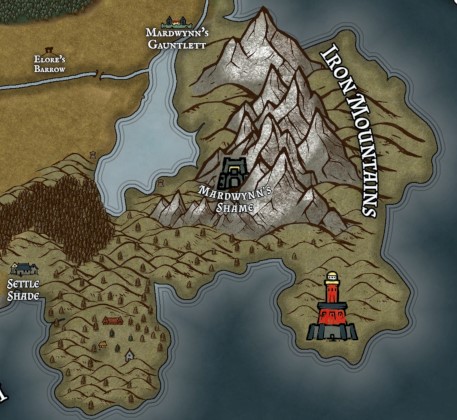Iron Mountains
Rising from small rolling foothills and the sea known as Wastru's incursion, the Iron Mountains stand tall and proud over the whole continent of Eternarii. The scraggy grass of the foothills eventually gives way to bare rock thousands of feet above the seas until finally, the ice and snow-capped peaks crown the range as a noble feature of the world.
The mountains first gained their moniker as the dwarves who traditionally lived in the caves and caverns beneath and around the range ventured forth with their superior metalwork technologies. Iron was first discovered by these dwarves who eventually brought their technology to the rest of Eternarii. At this time it was said that the entire mountain range was made of iron only. Over time iron and other metals were discovered elsewhere, but by this time the moniker was permanent.
Geography
A connected range of eight prominent mountain peaks all 15000ft above the level of Wastru's Incursion, capped with snow and ice. Various smaller peaks provide hardy adventurers stunning views over the expansive plains and arable lands to the West, glimpses of the wide forest of Corrilwal, and the shining crystals seas of Wastru's Incursion to the East, and the Circular Sea to the South.
Climate
High Altitudes (3000ft upwards)
At high altitudes, the weather is best described as inhospitable. Freezing, turbulent winds lash the peaks and higher isolated patches of the mountains. Giant birds navigate these gusts of turbulence to hunt and the lower altitudes free from the bother of the other life that calls the peaks its home.
Medium Altitude (1500-3000ft)
At medium altitudes the mountains take on an entirely different character. To the leeward or inland side of the mountain range, warm air currents rush in creating great thermals for all sorts of winged creatures to take advantage of. To the windward or seaward side of the mountain range, many hurricanes, tempests and fierce storms break and weaken. Between peaks, this creates a collision of warm and cool air currents almost daily meaning low-lying cloud cover from which tremendous thunder and lightening strikes the stone mountain sides below.
Low Altitudes (sub 1500ft)
In the foothills of the region, storms, rain, and even light snow flurries are common. This makes it surprising difficult for plantlife to grow in any significant size. Winds whip fiercely from all sides ensuring that beneath every crag, under every outcrop, and inside every cave you are sure to find signs of life sheltering from the harsh weather.
Fauna & Flora
Wild and hardy grasses alongside large root vegetables grow well on the foothills of the region . Higher up the mountain range beyond the occasional spruce or conifer tree the most plant life likely to be stumbled across are saxifraga commonly known as Rockfoil. Growing in small clusters, these delicate flowers frequently take root in tiny cracks of rocks, eventually developing root systems strong enough to crack even the densest rock in two.
Walking through the Iron Mountains you'll commonly find goats, elk and similar grazing herbivores providing vital prey for the lions, griffons, and mid-sized predators. These small carnivores in turn provide sources of prey for the larger creatures like Manticores, Drakes and Orges. All of these creatures frequently become the prey of the giants and dragons seen in the highest peaks of the mountains.
Through the air, all types of flying beasts can be observed hunting rodents and other smaller beasts.
Natural Resources
Despite their name, Hematite was discovered in the sedimentary rock formations beneath the foothills along the coastline. Meanwhile copper and tin ores can frequently be discovered along the lakeshore to the west of the mountains. Deep within and beneath the mountains themselves is found Gold, Silver and many other metals including the famed Mithral for which Dwarven smiths were particularly known.
- Air Elemental
- Annis Hag
- Baslilisk
- Blood Hawk
- Bulette (Land Sharks)
- Chimera (Snow Variety)
- Cloud Giant
- Cyclops
- Dire Troll
- Eagle
- Ettin
- Frost Giant
- Geleb Duhr
- Giant Eagle
- Giant Elk
- Giant Goat
- Goat
- Griffon
- Guard Drake (White)
- Half-Ogre
- Harpy
- Hippogriff
- Ki-rin
- Lion (Mountain)
- Manticore
- Ogre
- Roc
- Stone Giant
- Swarm of Bats
- Troll
- Wyvern (Extinct?)
Remove these ads. Join the Worldbuilders Guild









Comments